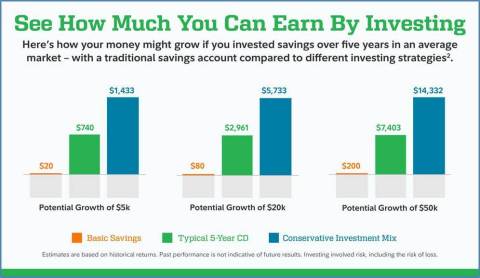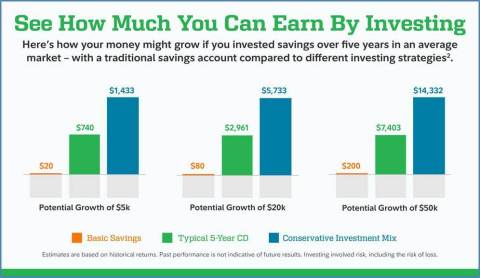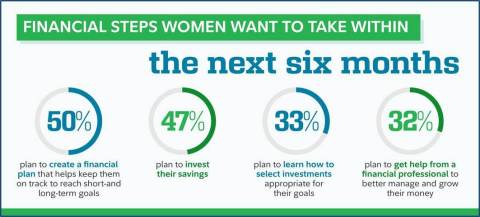BOSTON--(BUSINESS WIRE)--Fidelity Investments® today shared the results of its 2018 Women and Investing Study which finds that nearly three quarters (72 percent) of women across all ages plan to take steps within the next six months to make their money work harder and grow1. This should come as no surprise, as a majority of women embrace the role of CFO of their households, confidently managing day-to-day finances and making large purchases (e.g., buying new homes, cars).
Today, nearly half (44 percent) of women are already taking action by investing savings they have outside of retirement accounts and emergency funds in stocks and bonds, but compared to 59 percent of men who invest, there’s still opportunity for more women to grow their wealth. With more than half of women (56 percent) still not investing, and leaving nearly all their savings in cash or bank accounts – which on average earn less than a one percent return – many may be missing out on thousands of dollars in potential earnings.
The good news is that more women are recognizing that it’s time to take action and demand more of their money. Millennial women are leaning in most, with nearly half (48 percent) already investing, followed by approximately 40 percent of their Gen X and baby boomer counterparts.
“Women need to demand more from their money, so they can control their financial futures,” said Kathleen Murphy, president of Fidelity Investments’ personal investing business. “Women deserve to have their hard earned savings work just hard as they do every day. Fidelity is challenging the traditional financial services industry approach to how to best serve women, to help them grow their wealth and achieve their goals.”
To get off the sidelines and become more hands-on in growing their money, women will need additional support and education to help reframe how they think about investing, and ultimately take that next step. Still today, only one-in-four (24 percent) say they are comfortable with their knowledge about investing. In fact, if given $25,000 to invest today, less than half (44 percent) say they would know what steps to take to do so.
Two-thirds (65 percent) believe they need to learn more about picking individual stocks before they can get started. It’s important to remember that there are many options to getting invested. There are simple approaches and tools to help choose investments appropriate for your goals, and abundant help to ensure confident decision-making.
What’s the Opportunity: Calculating Potential
With more than
a third (35 percent) of women reporting they have $50,000 or more
sitting in savings, the growth potential can be staggering over time.
Consider these hypothetical examples2 for a shorter term
goal, looking at how investing $5,000, $20,000 and $50,000 can
potentially grow over the course of five years.
Putting an End to Sleepless Nights Due to Money Concerns
Forty
percent of women admit that worry about their finances keeps them up at
night at least once a month (including half of millennial and 43 percent
of Gen X women). However, women seem to be ready to put those sleepless
nights to bed with so many intending to take steps in the next six
months to get more hands-on with their finances and ensure their money
is working harder to grow.3
“It’s encouraging to see women taking greater control of their finances, and so many starting to make the move from saver to investor,” said Lorna Kapusta, vice president of women and investing at Fidelity. “We know from Fidelity’s own analysis of millions of customers across the country, when women do take steps to get invested, they see positive results. We believe that progress begets progress, so we’re committed to bringing more attention to the opportunity investing offers to make our money work harder, and to create that ‘ah-ha moment’ that really brings to life how investing can help reach goals faster, encouraging women to take action.”
Four Tips to Rethink Investing and Make Your Money Work as Hard as
You Do
Taking steps to better manage your financial life can
also bring greater peace of mind. Sixty-three percent of women say that
developing a financial plan for their short- and long-term goals made
them feel more confident about the future. Here are four steps to help
get you started.
1. Take inventory of what you own and what you owe, and see where you may have opportunities to do more with your money with a 10-minute Financial Wellness check-up.
2. Rethink investing at your own pace by checking out Fidelity.com/DemandMore. This new site was designed to provide more clarity around investing and help women build their own financial roadmap to reaching their individual goals.
- You’ll find resources to break down fundamental questions such as “what is risk” and “what does it mean to diversify,” as well as learn more about different investment products and strategies.
- Learn how women in different life situations are achieving personal goals and overcoming challenges by making their money work harder in their own lives.
3. Maximize the opportunity to grow your money by creating a plan now. Fidelity retail account owners can go here to visualize how different saving and investing options can help reach your short- and long-term goals. Not a Fidelity customer yet? Answer seven easy questions here to get a recommended strategy and suggested next steps to reach your personal goal.
4. Leverage an expert. Everyone has questions, so don't hold back from asking for guidance. Just like you visit a doctor for medical advice, why wouldn't you take advantage of a financial professional for investment advice? There are many free seminars, webcasts and other educational opportunities available to fit into busy lifestyles and help guide you to your best next financial step, whether through your workplace, investment companies like Fidelity, or other sources online. Fidelity representatives are available to answer questions 24/7 at 1-800-FIDELITY, or online at Fidelity.com – whether you’re a client or not.
About the Study
Fidelity’s 2018 Women and Investing Study
was conducted online between September 7th and September 18th,
2018 among 1,172 American women ages 21+. All respondents were employed
and actively contributing to an employer-sponsored retirement plan such
as a 401(k), 403(b), 401(a) or 457, with an income of $50,000+. For
comparison, 300 American men with the same criteria were surveyed.
Fidelity Investments was not identified as the sponsor, and the survey
was conducted by market research firm CMI.
About Fidelity Investments
Fidelity’s mission is to inspire
better futures and deliver better outcomes for the customers and
businesses we serve. With assets under administration of $7.4 trillion,
including managed assets of $2.6 trillion as of September 30, 2018, we
focus on meeting the unique needs of a diverse set of customers: helping
more than 28 million people invest their own life savings, 23,000
businesses manage employee benefit programs, as well as providing more
than 13,000 financial advisory firms with investment and technology
solutions to invest their own clients’ money. Privately held for 70
years, Fidelity employs more than 40,000 associates who are focused on
the long-term success of our customers. For more information about
Fidelity Investments, visit https://www.fidelity.com/about.
Fidelity, Fidelity Investments, Fidelity Investments and the pyramid logo are registered service marks of FMR LLC.
The third party trademarks appearing herein are the property of their respective owners.
Keep in mind that investing involves risk. The value of your investment will fluctuate over time, and you may gain or lose money.
Diversification and asset allocation do not ensure a profit or guarantee against loss.
Fidelity Brokerage Services LLC, Member NYSE, SIPC
900 Salem
Street, Smithfield, RI 02917
Fidelity Investments Institutional Services Company, Inc.
500 Salem
Street, Smithfield, RI 02917
National Financial Services LLC, Member NYSE, SIPC
200 Seaport
Boulevard, Boston, MA 02110
865837.1.0
© 2018 FMR LLC. All rights reserved.
1 Ipsos Omnibus Survey of 553 working women, 651 working men,
18 years and older, October 19-21, 2018
2 Projections
are based on past performance. Past performance does not predict future
results. The timing of deposits and when you are looking to use the
money can impact potential return as well as which savings or investment
options may be right for you. Hypothetical models include the following
assumptions:
- The average market return corresponds to the 50th percentile of the returns. Conservative Investing mix is based on 20% stocks, 50% bonds, 30% short term investments. Estimated/Average return rates stay constant over the course of the goal
- You won't make any withdrawals from the account during the goal timeframe
- No fees or taxes will be applied
- Your starting amount and monthly contributions are invested in the model allocation in the stated time period
- Investments in "traditional savings" and "locked savings" assumes only FDIC insured accounts or certificates of deposits are used
For investing returns, calculations are made by computing the 1, 2, 3,
4, 5, 6, 7, 8, 9, and 10-year average annual returns based on monthly
historical performance of stocks, bonds and short-term instruments from
1926-2017, obtained from Ibbotson Associates. Past performance is no
guarantee of future results. Returns include the reinvestment of
dividends and other earnings. The assets are rebalanced monthly to the
stated asset mix. Any chart is for illustrative purposes only and does
not represent actual or implied performance of any investment option.
Stocks are represented by the Dow Jones Total Market Index from March
1987 to latest calendar year. From 1926 to February 1987, stocks are
represented by the Standard & Poor's 500® Index (S&P 500® Index). The
S&P 500® Index is a market capitalization-weighted index of 500 common
stocks chosen for market size, liquidity, and industry group
representation to represent U.S. equity performance. Bonds are
represented by the Barclays U.S. Aggregate Bond Index from January 1976
to the latest calendar year. The Barclays U.S. Aggregate Bond Index is a
market value-weighted index of investment-grade fixed-rate debt issues,
including government, corporate, asset-backed, and mortgage-backed
securities, with maturities of one year or more. From 1926 to December
1975, bonds are represented by the U.S. Intermediate Government Bond
Index, which is an unmanaged index that includes the reinvestment of
interest income. Short-term instruments are represented by U.S. Treasury
bills, which are backed by the full faith and credit of the U.S.
government. The average market return corresponds to the 50th percentile
of the returns, the below average market return corresponds to the 25th
percentile of the returns, and the significantly below average market
return corresponds to the 10th percentile of the returns. Savings
returns are calculated using a national average savings account rate
from FDIC. Locked rate savings returns are calculated using national
average CD rates for 1-, 2- and 5-year CDs from BankRate. CDs are
assumed to be purchased once and are not being rolled over upon
maturity. When purchasing CDs from within a savings account, all
additional monthly contributions into the savings account, as well as
continuing savings with the proceeds of a CD after it matures, are
assumed to be earning a national average saving account rate from FDIC.
3
Ipsos Omnibus Survey of 553 working women, 651 working men, 18 years and
older, October 19-21, 2018





